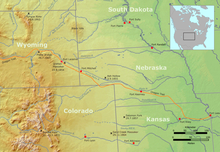Grattan massacre
The Grattan massacre is a battle named after US Lieutenant John L. Grattan, which took place on August 19, 1854 between US troops and Indians and was the first significant armed confrontation between the US Army and the Lakota.
The battle
In late summer of that year, various Lakota tribes encamped about twelve kilometers east of Fort Laramie in what is now southeastern Wyoming . They were waiting for supplies that had been guaranteed to them by the US government in the Treaty of Fort Laramie in 1851 three years earlier. The cow of a Mormon traveling west on the nearby Oregon Trail got lost in the Brulé- Lakota camp and was captured and killed by a Minneconjou named High Forehead, who was visiting the Brulé.
The owner of the cow complained at the fort, and Lieutenant John Lawrence Grattan, a young officer recently graduated from Westpoint , was ordered by the commandant to arrest the guilty Lakota and bring him to the fort for punishment. Grattan's force consisted of a sergeant , a corporal , 27 soldiers and a French-born interpreter. The commandant of Fort Laramie later testified: There is no doubt that Lieutenant Grattan left the fort with the firm intention of catching the man at all costs, even if there was a fight.
The chief of the Brulé, Conquering Bear , obviously wanted to protect the guilty party. He tried to negotiate the case and offered a horse as compensation, but Grattan categorically declined the offer. The tense situation was no doubt exacerbated by the drunk interpreter who insulted the Indians. When Conquering Bear stood up indignantly and was about to leave the consultation, a soldier shot him in the back and killed him. An exchange of fire ensued, in which Grattan and almost all of his thirty companions were killed. Only one soldier was able to escape seriously wounded, but is said to have died later from his wounds. Allegedly, the Conquering Bear was the only Indian who lost his life in this battle.
consequences
This event was called the Grattan Massacre by the American press and was part of a large-scale anti-Indian press campaign in the United States at that time.
When the news reached the Department of War in Washington , they were determined to retaliate. Colonel William S. Harney , a highly decorated officer from the Mexican-American War (1846-1848), was specially summoned from Paris and sent to Fort Kearny , where he took command of the Dragoons stationed there . On August 24, 1855, he began his campaign to punish the Lakota for the Grattan massacre.
After an unsuccessful attempt at negotiation by the Brulé, about 600 US cavalrymen attacked the Indian camp on Blue Water Creek in western Nebraska on September 3, 1855 . The Brulé under Chief Little Thunder, the successor to Conquering Bear, numbered only 250 warriors, were clearly inferior and lost at least 85 tribal members, including many women and children. A significant number of Lakota women and children were abducted. The Sioux called Harney, who was later promoted to general, who since Butcher (Engl. Butcher). Crazy Horse , later a famous chief, was still an adolescent at the time. He is said to have been both at the Grattan incident in the Lakota camp and to have observed from a distance the massacre at Blue Water Creek, also known as the Battle of Ash Hollow .
See also
Indian wars , time table of the Indian wars
literature
- Paul Norman Beck: The First Sioux War: The Grattan Fight and Blue Water Creek, 1854-1856 . University Press of America, 2004 ( excerpt (Google) )
- Robert M. Utley : The Indian frontier of the American West: 1846-1890 . Albuquerque: Univ. of New Mexico Press, 1984 (not yet evaluated for this article)
- Charles Barron McIntosh: The Nebraska Sand Hills: The Human Landscape . University of Nebraska Press, 1996, ISBN 978-0-8032-3184-9 , pp. 65-69 ( excerpt (Google) )
- R. Eli Paul: Blue Water Creek, Battle of , Grattan Massacre . In: James A. Crutchfield (Ed.), Candy Moutlon (Ed.), Terry Del Bene (Ed.): The Settlement of America: An Encyclopedia of Westward Expansion from Jamestown to the Closing of the Frontier . Routledge, 2015, ISBN 978-0-7656-1984-6 , pp. 92-93, 237-238
Web links
- National Park Service: Potpourri Of Fort Laramie Facts ( Memento of November 27, 2010 in the Internet Archive ) with a brief description of Brevet 2nd Lieutenant John L. Grattan and the events of August 19, 1854

